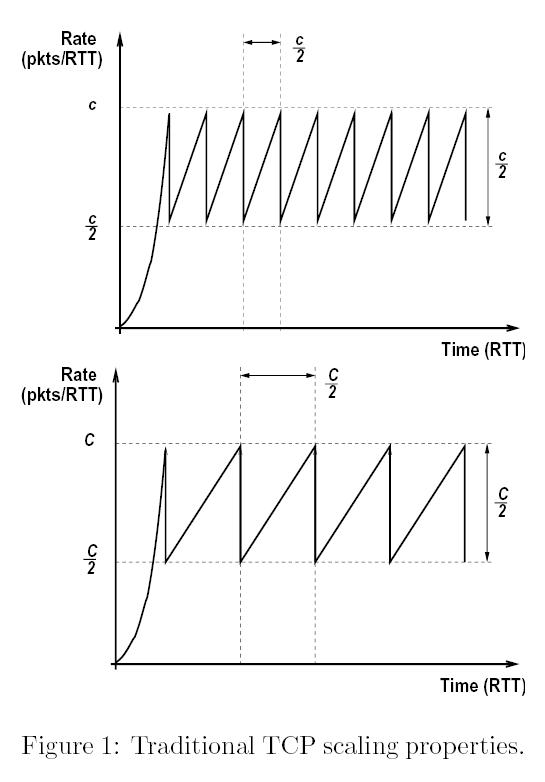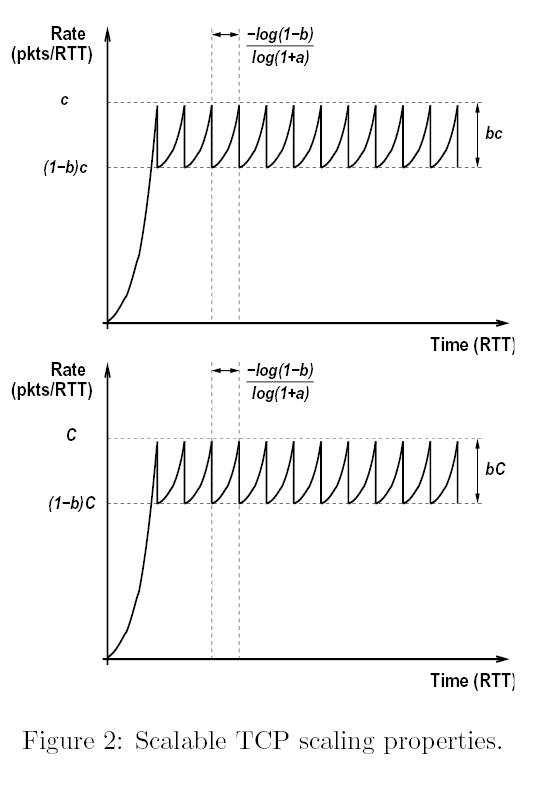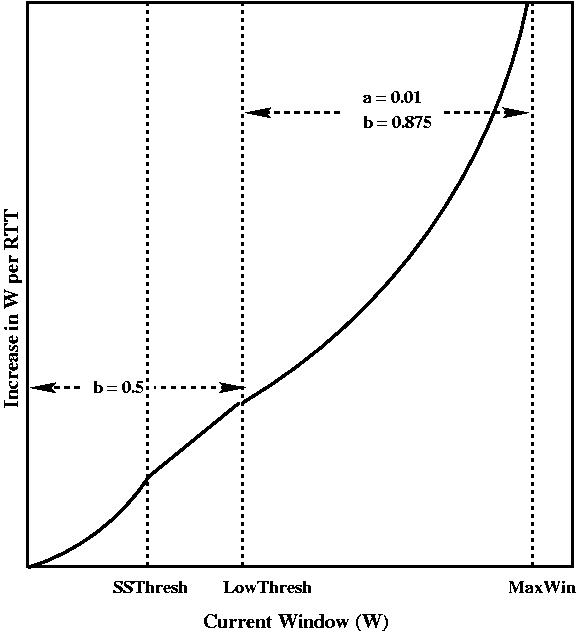Trend: High-speed networks
Objective: Design transport protocols that enable applications
to utilize large capacities.
Problems with Standard TCP: Can't utilize available capacity.
To achieve 10 Gbps with a 100 ms round-trip time, we need a window
size ~ 83,000 packets. The following issues make it difficult for
Standard TCP to maintain this window size.
- Steady-State:

(Figure from [Kelly03])
- If congestion events occur frequently, average throughput will
be less than C.
Qn: Would the fraction of link capacity utilized in
both cases be different? Is there something wrong with the
picture?
- Floyd's alternative argument: To achieve 10 Gbps, only 1
in (2 x 10^{-10}) packets should be dropped.
``This is probably past the limits of achievable fiber
error rates.'' [Floyd02]
Qns:
- Is that true?
``A packet loss rate of 10-7 is comparable with
those that can occur on long haul fiber links,
within network devices, and in end-systems; this
places a limit on throughput before any transient
congestion due to load fluctuations are
considered.'' [Kelly03]
- Why should recovery from fiber error rates be dealt
with at the transport layer?
In particular, why should TCP reduce its sending
window significantly in response to fiber ``error''
rates?
- Slow-Start:
Start with a window of 1 packet.
- Multiplicatively increase till SSthresh.
- Additively increase beyond SSthresh.
Could take hours to achieve a window size of a 100 thousand
packets.
Qn: Is this true? Doesn't SSthresh control the ramp-up time?
- Recovery from Consecutive Time-Outs:
When 2 consecutive timeouts occur, ssThresh drops to 1 and
and sender has to use additive increase only to ramp-up its
window size.
This could certainly take several hours.
------------------------------------------------------------------------------------
Design Goals for High-speed TCP:
- Achieve high throughput
- Without requiring unrealistically low packet loss rates.
- Quickly during slow-start.
- After recovering quickly from multiple retransmit timeouts.
- Do not require changes to routers and TCP receivers
(sender-side modifications only).
- TCP-friendly performance.
- . . . (see [Floyd03])
------------------------------------------------------------------------------------
High-speed TCP / Scalable TCP:
(basic ideas)
- For High Throughput:
- Increase window size more aggressively (multiplicative
increase).
Standard TCP:
- every RTT, newW = d + oldW,
HS-TCP:
- every RTT, newW = (1+a) x oldW,
- Decrease window size less aggressively (smaller factor).
newW = b*oldW, where b > 0.5

(Figure from [Kelly03])
- For TCP-friendliness:
- Under conditions of moderate-to-high congestion (W <
LowThresh), behave exactly the same as Standard TCP.
- At low loss rates (W > LowThresh), do not be concerned with
TCP-friendliness, as Standard TCP can't utilize high
available capacity anyways.

------------------------------------------------------------------------------------
Issues:
- Is it really true that the TCP receiver need not be modified?
What about receive window settings?
What about flurry of Selective-ACKs due to large windows?
- Is it really true that routers need not be modified?
What about buffer space?
- How to pick LowThresh?
- Doesn't deal with Slow-Start and multiple consecutive timeouts.
- How do multiple HS-TCP flows interact?
Are there any oscillations due to synchronization?
------------------------------------------------------------------------------------
References:
|
[Floyd02]
|
S. Floyd, S. Ratnasamy, S. Shenker, "Modifying TCP's Congestion
Control for High Speeds", May 2002.
|
| |
|
[Floyd03]
|
S. Floyd, "HighSpeed TCP for Large Congestion Windows", Internet
Draft, July 2003.
|
| |
|
[Kelly03]
|
T. Kelly, "Scalable TCP: Improving Performance in HighSpeed
Wide Area Networks", First International Workshop on
Protocols for Fast Long-distance Networks, February 2003.
|
------------------------------------------------------------------------------------


